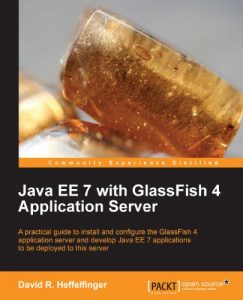About This Book
- Install and configure GlassFish 4
- Covers all major Java EE 7 APIs and includes new additions such as JSON Processing
- Packed with clear, step-by-step instructions, practical examples, and straightforward explanations.
Who This Book Is For
If you are a Java developers who wants to become proficient with Java EE 7, this book is ideal for you. Readers are expected to have some experience with Java and to have developed and deployed applications in the past, but don't need any previous knowledge of Java EE or J2EE.
What You Will Learn
- Develop web-based applications using JavaServer Faces (JSF) 2.2
- Interact with databases via the Java Persistence API (JPA) 2.1
- Create SOAP and RESTful web services via JAX_WS and JAX-RS APIs
- Develop Enterprise JavaBeans (EJBs), including session and message-driven beans
- Integrate enterprise application layers via Contexts and Dependency Injection (CDI) API
- Generate and parse JavaScript Object Notation (JSON) data via the JSON-P API
- Make WebSocket applications via the standard Java EE 7 WebSocket API
In Detail
GlassFish is a free, open source application server which supports all the major Java features such as Enterprise JavaBeans, JPA, JavaServer Faces, JMS, RMI, JavaServer Pages, and servlets. It is the first Java EE 7 compliant application server. All major Java EE technologies and API's are covered in this version of Java. GlassFish server allows the user to work with the extensile, adaptable, and lightweight Java EE 7 platform.
This book explores the installation and configuration of GlassFish, and then moves on to Java EE 7 application development, covering all major Java EE 7 APIs. It focuses on going beyond the basics to develop Java applications deployed to the GlassFish 4 application server. The book covers all major Java EE 7 APIs including JSF 2.2, EJB 3.2, CDI 1.1, the Java API for WebSocket, JAX-WS, JAX-RS and more.
The book also introduces JSON-P, the Java API for JSON (Javascript Object Notation) Processing. This advanced topic deals with how the two APIs are used to process JSON function, namely the Model API and the Streaming API. Apart from revisiting Java Server Faces (JSF), it explains why Facelets, the new features introduced in modern versions of JSF, are the preferred view technology over Java Server Pages (JSP)
The later chapters explore competing implementations of the WebSocket standard in Java, describing the updates in JMS; which aims to provide a simpler API and reduction in boilerplate code among a host of other features. Readers will also learn how to secure Java EE applications by taking advantage of GlassFish's built-in security features. Finally, we learn more about the RESTful web service development using the JAX-RS specification.



